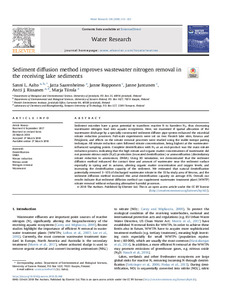Sediment diffusion method improves wastewater nitrogen removal in the receiving lake sediments
Aalto, Sanni L; Saarenheimo, Jatta; Ropponen, J; Juntunen, J; Rissanen, Antti J.; Tiirola, Marja (2018)
Aalto, Sanni L
Saarenheimo, Jatta
Ropponen, J
Juntunen, J
Rissanen, Antti J.
Tiirola, Marja
2018
Julkaisun pysyvä osoite on
https://urn.fi/URN:NBN:fi:tty-201804191515
https://urn.fi/URN:NBN:fi:tty-201804191515
Kuvaus
Peer reviewed
Tiivistelmä
Sediment microbes have a great potential to transform reactive N to harmless N2, thus decreasing wastewater nitrogen load into aquatic ecosystems. Here, we examined if spatial allocation of the wastewater discharge by a specially constructed sediment diffuser pipe system enhanced the microbial nitrate reduction processes. Full-scale experiments were set on two Finnish lake sites, Keuruu and Petäjävesi, and effects on the nitrate removal processes were studied using the stable isotope pairing technique. All nitrate reduction rates followed nitrate concentrations, being highest at the wastewater-influenced sampling points. Complete denitrification with N2 as an end-product was the main nitrate reduction process, indicating that the high nitrate and organic matter concentrations of wastewater did not promote nitrous oxide (N2O) production (truncated denitrification) or ammonification (dissimilatory nitrate reduction to ammonium; DNRA). Using 3D simulation, we demonstrated that the sediment diffusion method enhanced the contact time and amount of wastewater near the sediment surface especially in spring and in autumn, altering organic matter concentration and oxygen levels, and increasing the denitrification capacity of the sediment. We estimated that natural denitrification potentially removed 3–10% of discharged wastewater nitrate in the 33 ha study area of Keuruu, and the sediment diffusion method increased this areal denitrification capacity on average 45%. Overall, our results indicate that sediment diffusion method can supplement wastewater treatment plant (WWTP) nitrate removal without enhancing alternative harmful processes.
Kokoelmat
- TUNICRIS-julkaisut [16882]
